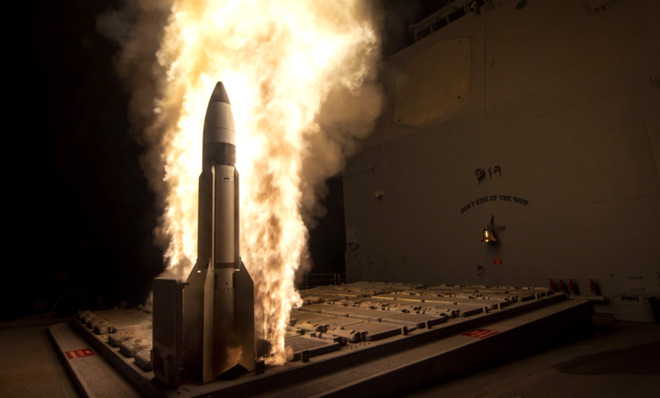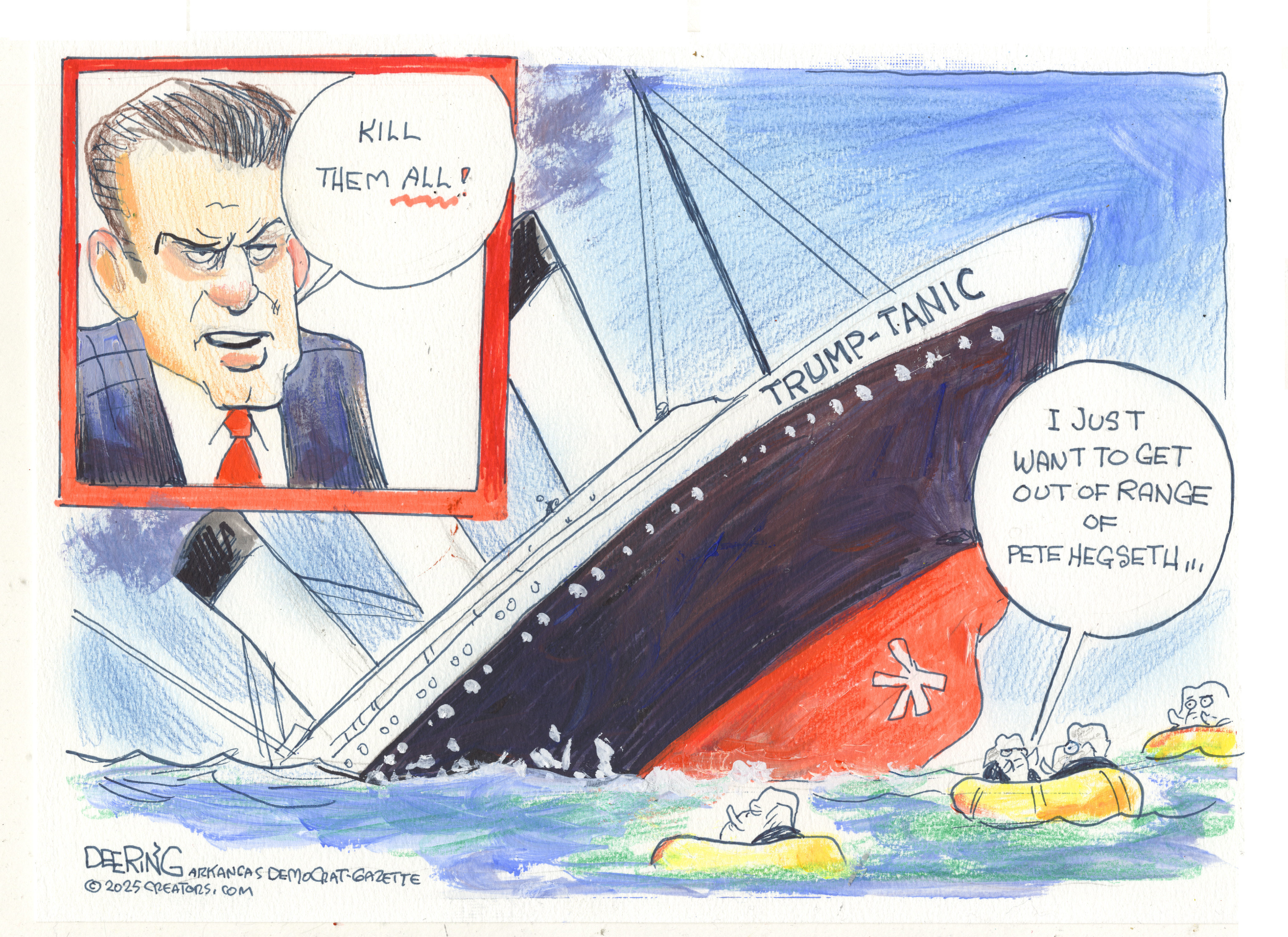Obama's new nuclear weapons
The road to Global Zero goes through 1,550


The U.S government today released a precise accounting of its strategic nuclear forces, something it is required to do by treaty, and it's worth a careful read.
The world now knows that, by February of 2018, the U.S. will have approximately 400 intercontinental ballistic missiles, down from 450; 240 submarine-launched ballistic missiles, down about 50; and 60 nuclear-capable heavy bomber fighters (B-2As and B-52Hs), converting 30 B-52s to a non-nuclear role.
Since most of the nuclear payloads contain multiple warheads, the U.S. must also disclose the number of strategic nuclear weapons it will maintain on an alert status. As of 2018, that will be 1,550.
The Week
Escape your echo chamber. Get the facts behind the news, plus analysis from multiple perspectives.

Sign up for The Week's Free Newsletters
From our morning news briefing to a weekly Good News Newsletter, get the best of The Week delivered directly to your inbox.
From our morning news briefing to a weekly Good News Newsletter, get the best of The Week delivered directly to your inbox.
The good news: the number of viable nuclear warheads in the world will go down. President Obama has prioritized nuclear arms reduction, and the Senate in 2010 ratified a treaty with Russia that reduces to 700 the number of nuclear delivery vehicles. (The U.S. can keep an extra 100 platforms in storage.)
The timing is interesting, of course, but the decisions to reduce certain types of weapons is even more interesting. Of the three "guns," the silo-based ICBMs are the oldest, the least efficient, and operated by missileers who have had well-publicized troubles with cheating and morale. But the cuts to that "leg" of the triad are much smaller, proportionally, than the cuts sustained by the Air Force's nuclear fighter wings and the Navy's ballistic missile submarines.
It may well be that the Obama administration decided to boost the confidence of the missileers, but the plan to keep most of the ICBMs might serve another purpose. It will require future administrations to cut the ICBM force more heavily, while giving nuclear planners more time to adapt the new set of platforms to existing targets. The composition of the nuclear force is unclassified; virtually everything else about nuclear war remains a state secret.
For example: cutting the number of strategic warheads will force a big change to the Joint Strategic Capabilities Supplement annex to the current nuclear war plan, OPLAN 8010-12 Strategic Deterrent and Force Employment, as well as to the exercises used to test forces on the plan and the intelligence that guides it. Also, the U.S. maintains a stockpile of battlefield nuclear weapons, which have "yields," or explosive power equivalent to as little as 300 tons of TNT. Most are kept in storage in bunkers across the world. Their locations, types, and numbers are classified, although the U.S. admits to a force of at least 500 "battlefield" weapons.
A free daily email with the biggest news stories of the day – and the best features from TheWeek.com
The U.S. also keeps a big reserve of nuclear weapons material and equipment — the "nuclear strategic reserve," which, while disassembled, do not count towards any of the treaty's red lines. As of 2010, the reserve stock was equivalent to 2,800 weapons. These are intended (in nuclear doctrine) to hedge against strategic surprise, but the number is probably significantly higher than it needs to be, particularly if the classified target countries (China, North Korea, Russia, Iran, Syria) are no longer formally chartered enemies.
Though President Obama has changed the policy undergirding the employment of nuclear weapons, the exact language of the war plan, as well as the thresholds that might trigger the consideration for the use of nuclear weapons, remain classified, even though there is considerable ambiguity built into the precision. It is not known, for example, how flexible the U.S. can be in response to a conventional attack from a non-nuclear country, like Syria. After 9/11, a "WMD hedge" was built into the war plan, too. The U.S. does not rule out using nuclear weapons to respond to a terrorist attack from a non-state actor.
Marc Ambinder is TheWeek.com's editor-at-large. He is the author, with D.B. Grady, of The Command and Deep State: Inside the Government Secrecy Industry. Marc is also a contributing editor for The Atlantic and GQ. Formerly, he served as White House correspondent for National Journal, chief political consultant for CBS News, and politics editor at The Atlantic. Marc is a 2001 graduate of Harvard. He is married to Michael Park, a corporate strategy consultant, and lives in Los Angeles.
-
 In Suriname, the spectre of Dutch slave trade lingers
In Suriname, the spectre of Dutch slave trade lingersUnder the Radar Dutch royal family visit, the first to the South American former colony in nearly 50 years, spotlights role of the Netherlands in transatlantic trade
-
 Political cartoons for December 7
Political cartoons for December 7Cartoons Sunday’s political cartoons include the Trump-tanic, AI Santa, and the search for a moderate Republican
-
 Trump’s poll collapse: can he stop the slide?
Trump’s poll collapse: can he stop the slide?Talking Point President who promised to ease cost-of-living has found that US economic woes can’t be solved ‘via executive fiat’
-
 Has Zohran Mamdani shown the Democrats how to win again?
Has Zohran Mamdani shown the Democrats how to win again?Today’s Big Question New York City mayoral election touted as victory for left-wing populists but moderate centrist wins elsewhere present more complex path for Democratic Party
-
 Millions turn out for anti-Trump ‘No Kings’ rallies
Millions turn out for anti-Trump ‘No Kings’ ralliesSpeed Read An estimated 7 million people participated, 2 million more than at the first ‘No Kings’ protest in June
-
 Ghislaine Maxwell: angling for a Trump pardon
Ghislaine Maxwell: angling for a Trump pardonTalking Point Convicted sex trafficker's testimony could shed new light on president's links to Jeffrey Epstein
-
 The last words and final moments of 40 presidents
The last words and final moments of 40 presidentsThe Explainer Some are eloquent quotes worthy of the holders of the highest office in the nation, and others... aren't
-
 The JFK files: the truth at last?
The JFK files: the truth at last?In The Spotlight More than 64,000 previously classified documents relating the 1963 assassination of John F. Kennedy have been released by the Trump administration
-
 'Seriously, not literally': how should the world take Donald Trump?
'Seriously, not literally': how should the world take Donald Trump?Today's big question White House rhetoric and reality look likely to become increasingly blurred
-
 Will Trump's 'madman' strategy pay off?
Will Trump's 'madman' strategy pay off?Today's Big Question Incoming US president likes to seem unpredictable but, this time round, world leaders could be wise to his playbook
-
 Democrats vs. Republicans: who are US billionaires backing?
Democrats vs. Republicans: who are US billionaires backing?The Explainer Younger tech titans join 'boys' club throwing money and support' behind President Trump, while older plutocrats quietly rebuke new administration
